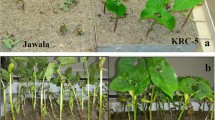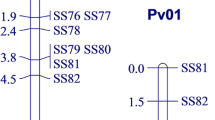Abstract
Anthracnose, caused by the fungusColletotrichum lindemuthianum, is a severe disease of common bean (Phaseolus vulgaris L.) controlled, in Europe, by a single dominant gene,Are. Four pairs of near-isogenic lines (NILs) were constructed, in which theAre gene was introgressed into different genetic backgrounds. These pairs of NILs were used to search for DNA markers linked to the resistance gene. Nine molecular markers, five RAPDs and four RFLPs, were found to discriminate between the resistant and the susceptible members of these NILs. A backcross progeny of 120 individuals was analysed to map these markers in relation to theAre locus. Five out of the nine markers were shown to be linked to theAre gene within a distance of 12.0 cM. The most tightly linked, a RAPD marker, was used to generate a pair of primers that specifically amplify this RAPD (sequence characterized amplified region, SCAR).
Similar content being viewed by others
References
Adam AF, Creusot F, Grisvard J, Sevignac M, Choisne N, Dron M (1993) Reverse genetics as an approach to isolate a french bean resistance gene against anthracnose. In: Fritig B, Legrand M (eds) Mechanisms of plant defense responses. Kluwer Academic Publishers, Netherlands, pp 33–36
Beckmann JS, Soller M (1983) Restriction fragment length polymorphism in genetic improvement: methodology, mapping and costs. Theor Appl Genet 67: 35–43
Beebe SE, Pastor-Corrales MA (1991) Breeding for disease resistance in common beans. In: Van Schoonhoven A, Voysest O (eds) Common beans: research for crop improvement. CAB International Oxford, pp 561–610
Charrier A, Bannerot H (1970) Contribution à létude des races physiologiques de l'anthracnose du haricot. Ann Amélior Plant 18: 171–179
Church G, Gilbert W (1984) Genomic sequencing. Proc Natl Acad Sci USA 81: 1991–1995
Debener T, Lehnackers H, Arnold M, Dangl JL (1991) Identification and molecular mapping of a singleArabidopsis locus conferring resistance against a phytopathogenicPseudomonas isolate. The Plant J 1: 289–302
Dellaporta SL, Wood J, Hicks JB (1983) A plant DNA micropreparation: version II. Plant Mol Biol Rep 1: 19–21
Fouilloux G (1979) New races of bean anthracnose and consequences on a breeding program. In: Maraite H, Meyer JA (eds) Diseases of tropical foodcrops. Université Catholique Louvain la Neuve, Belgique, pp 221–235
Fouilloux G, Bannerot H (1977) Four pairs of isogenic lines except for the “ARE gene”. Bean Improv Coop 20: 59–60
Gantet P, Bettini P, Grisvard J, Dron M (1991) Genetic linkage betweenMexII, a specific resistance gene to anthracnose andAnp, a gene involved in pod anthocyanin accumulation in bean. Plant Dis 75: 941–942
Gardiner JM, Coe EM, Melia-Hancock S, Hoisington DA, Chao S (1993) Development of a core RFLP map in maize using an immortalized F2 population. Genetics 134: 917–930
Gepts P (1993) Linkage map of common bean (Phaseolus vulgaris L.). In: Obrien SL (ed) Genetic maps. Cold Spring Harbor Laboratory, Cold Spring Harbor, New York, pp 6101–6109
Gepts P, Nodari R, Tsai SM, Koinange EMK, Llaca V, Gilbertson R, Guzman P (1993) Linkage mapping in common bean. Annu Rept Bean Improv Coop 93: 24–25
Haley SD, Miklas PN, Stavely JR, Byrum J, Kelly JD (1993) Identification of RAPD markers linked to a major rust resistance gene block in common bean. Theor Appl Genet 86: 505–512
Hospital F, Chevalet C, Mulsant P (1992) Using markers in gene introgression breeding programs. Genetics 132: 1199–1210
Kosambi DD (1944) The estimation of map distances from recombination values. Ann Eugen 12: 172–175
Lander ES, Green P, Abrahamson J, Barlow A, Daly M, Lincoln SE, Newburg L (1987) MapMAKER: an interactive computer package for constructing primary genetic linkage maps of experimental and natural populations. Genomics 1: 174–181
Lenné JM (1992)Colletotrichum diseases of legumes. In: Bailey JA, Jeger MJ (eds)Colletotrichum biology, pathology and control. CAB International, Oxford, pp 134–167
Mahé A, Grisvard J, Dron M (1993) Two avirulent races ofColletotrichum lindemuthianum trigger a different time-course of plant defense reaction in bean. Mol Plant-Microbe Interact 6: 423–428
Maniatis T, Fritsch EF, Sambrook L (1989) Molecular cloning: a laboratory manual. Cold Spring Harbor Laboratory, Cold Spring Harbor, New York
Martin GB, Williams JGK, Tanksley SD (1991) Rapid identification of markers linked to aPseudomonas resistance gene in tomato by using random primers and near-isogenic lines. Proc Natl Acad Sci USA 88: 2336–2340
Martin GB, De Vicente MC, Tanksley SD (1993) High-Resolution linkage analysis and physical characterisation of thePto bacterial resistance locus in tomato. Mol Plant-Microbe Interact 6: 26–34
Mastenbroek C (1960) A breeding program for resistance to anthracnose in dry shell haricot beans, based on a new gene. Euphytica 9: 177–258
Menezes JR, Dianese JC (1988) Race characterization of Brazilian isolates ofColletotrichum lindemuthianum and detection of resistance to anthracnose inPhaseolus vulgaris. Phytopathology 78: 630–655
Michelmore RW, Kesseli RV, Francis DM, Paran I, Fortin MG, Young CH (1992) Strategies for cloning plant disease resistance genes. In: Gurr S (ed) Molecular plant pathology, a practical approach, vol 2. IRC Press, Oxford, UK, pp 233–287
Muehlbauer GJ, Specht JE, Thomas-Compton MA, Staswick PE, Bernard RL (1988) Near-isogenic-lines. A potential resource in the integration of conventional and molecular marker linkage maps. Crop Sci 28: 729–735
Muehlbauer GJ, Staswick PE, Specht JE, Graef GL, Shoemaker RC, Keim P (1991) RFLP mapping using near-isogenic lines in soybean [Glycine max (L.) Merr.]. Theor Appl Genet 81: 189–198
Nodari RO, Tsai SM, Gilbertson RL, Gepts P (1993a) Towards an integrated linkage map of common bean. 2. Development of an RFLP-based linkage map. Theor Appl Genet 85: 513–520
Nodari RO, Tsai SM, Guzmàn P, Gilberston RL, Gepts P (1993b) Towards an integrated linkage map of common bean. III. Mapping genetic factors controlling host-bacteria interactions. Genetics 134: 341–350
Paran I, Michelmore RW (1993) Development of reliable PCR-based markers linked to downy mildew resistance genes in lettuce. Theor Appl Genet 85: 985–993
Park SJ, Tu JC, Aylesworth JW (1987) Dresden field bean. Can J Plant Sci 67: 821–822
Pastor-Corrales MA, Tu JC (1989) Anthracnose in bean production problems in the tropics. In: Schwartz MP, Pastor-Corrales MA (eds). CIAT, Cali, Colombia, pp 77–105
Pryor T (1987) The origin and structure of fungal disease resistance genes in plants. Trends Genet 3: 157–161
Reed KC, Man DA (1985) Rapid transfer of DNA from agarose gels to nylon membranes. Nucleic Acids Res 13: 7207–7221
Stam P, Zeven AC (1981) The theoretical proportion of the donor genome in nearisogenic lines of self-fertilizers bred by back-crossing. Euphytica 30: 227–238
Tanksley SD, Young ND, Paterson AH, Bonierbale MW (1989) RFLP mapping in plant breeding: new tools for an old science. Bio/Technology 7: 257–264
Vallejos CE, Sakiyama NS, Chase CD (1992). A molecular markerbased linkage map ofPhaseolus vulgaris L. Genetics 131: 733–740
Williams JGK, Hanafey MK, Rafalski JA, Tingey SV (1993) Genetic analysis using Random Amplified Polymorphic DNA markers. Methods Enzymol 218: 705–740
Young ND, Tanksley SD (1989) RFLP analysis of the size of chromosomal segments retained around theTm-2 locus of tomato during back-cross breeding. Theor Appl Genet 77: 353–359
Author information
Authors and Affiliations
Additional information
Communicated by J. Beckmann
The research was supported by the CNRS and the Ministère Français de l'Education Nationale
Rights and permissions
About this article
Cite this article
Adam-Blondon, A.F., Sévignac, M., Bannerot, H. et al. SCAR, RAPD and RFLP markers linked to a dominant gene (Are) conferring resistance to anthracnose in common bean. Theoret. Appl. Genetics 88, 865–870 (1994). https://doi.org/10.1007/BF01253998
Received:
Accepted:
Issue Date:
DOI: https://doi.org/10.1007/BF01253998




